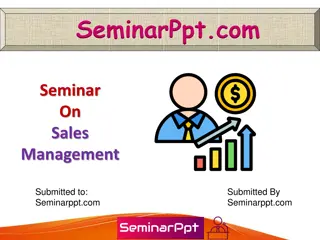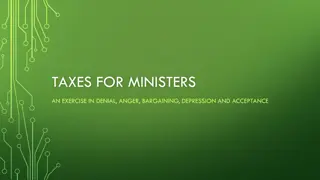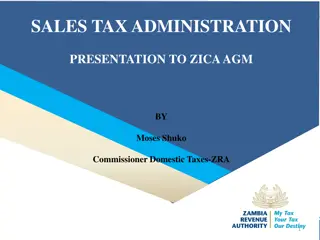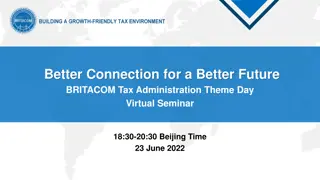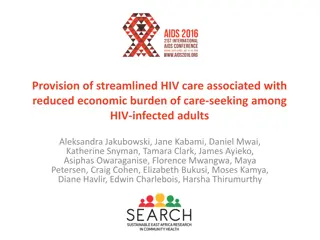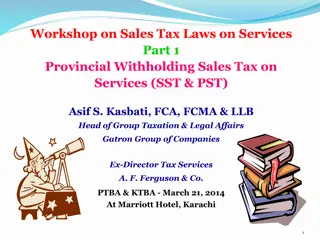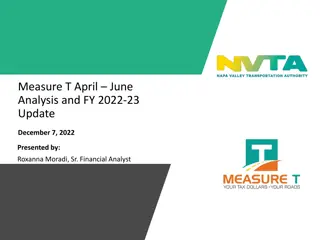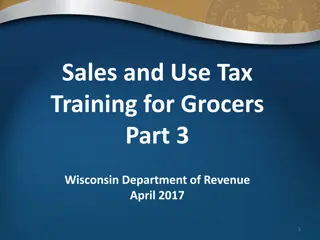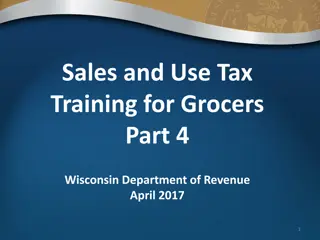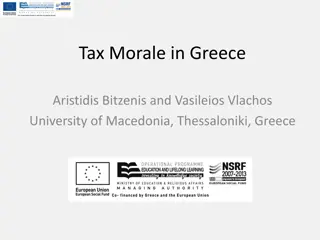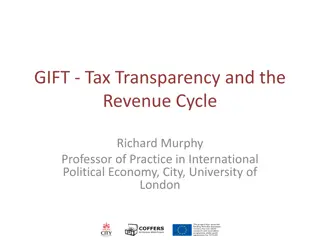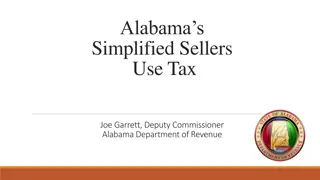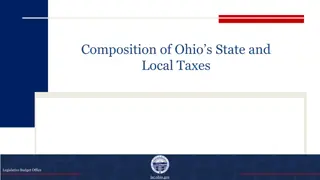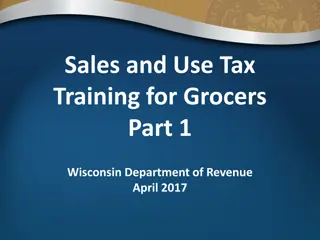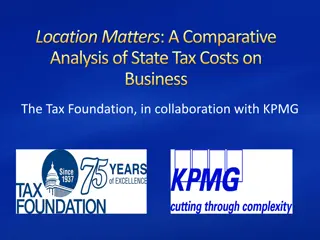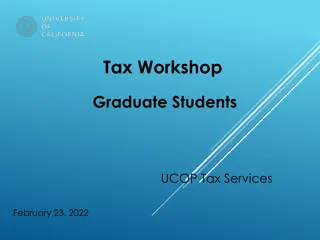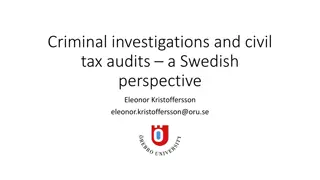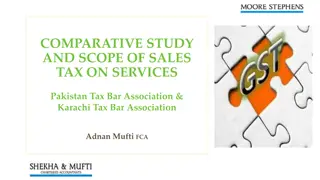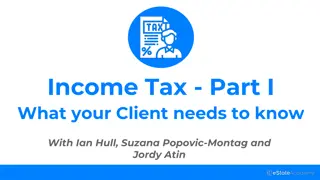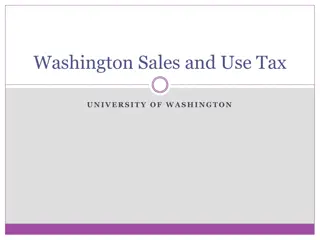Understanding Streamlined Sales Tax and Digital Products
Explore the background, objectives, and key information related to the Streamlined Sales Tax (SST) initiative, including its goals, history, participating entities, and membership status. Learn about efforts to simplify sales tax collection and achieve uniformity across state and local jurisdictions.
Download Presentation

Please find below an Image/Link to download the presentation.
The content on the website is provided AS IS for your information and personal use only. It may not be sold, licensed, or shared on other websites without obtaining consent from the author. Download presentation by click this link. If you encounter any issues during the download, it is possible that the publisher has removed the file from their server.
E N D
Presentation Transcript
Streamlined Sales Tax and Digital Products BACKGROUND AND GENERAL INFORMATION AND SPECIFIC TOPICS RELATED TO MTC DIGITAL PRODUCTS SURVEY
Agenda Agenda Background Streamlined digital products framework Sourcing Exemptions Bundled transactions Multiple points of use MTC whitepaper
What is Streamlined Sales Tax (SST)? What is Streamlined Sales Tax (SST)? Effort by State and Local Governments and Business Community Focus is on: Simplification Uniformity Removing burdens State sovereignty Recent efforts have focused significantly on removing taxpayer burdens through the use of disclosed practices.
What is SST? What is SST? - -Streamlined s Goals Streamlined s Goals 01 02 03 04 Create a simpler system for administering the various state and local sales taxes At least make processes uniform if they cannot be made simple Balance the interests of a state s sovereignty with the interests of simplicity and uniformity Leverage the use of technology to ease the retailer s tax collection and reporting
Why Did SST Start? Why Did SST Start? 1967 case of National Bellas Hess v. Illinois 1992 case of Quill Corp. v. North Dakota States do not have the authority to require sales tax collection by out-of- state retailers with no physical presence in a state Burdens imposed by States constituted an undue burden on interstate commerce and a violation of the Commerce Clause of U.S. Constitution
Whos Involved? Who s Involved? States Initially - All with a sales tax except CO involved in developing the SSUTA Voluntary Participation 23 Full member states 1 Associate member state Local Governments Business Community Businesses Tax Practitioners Business Associations
What Do We Do? Assist states as they administer a simpler and more uniform sales and use tax system. Simplify and modernize sales and use tax administration in order to substantially reduce the burden of tax compliance. Improve sales and use tax administration systems for all sellers and for all types of commerce.
Background: Ideas on How to Reduce Some of the Background: Ideas on How to Reduce Some of the Burdens Burdens One level of tax administration per state no locally administered sales taxes Set-up a central registration system Have one rule that establishes who has the right to tax a transaction Have fewer tax rates within each state and locality
Background: Ideas on How to Reduce Some of the Background: Ideas on How to Reduce Some of the Burdens Burdens Have the same state and local tax bases Have common definitions for the same product Do not make the retailer liable when a buyer lies or fails to provide proof of an exempt sale Have states disclose how certain items are treated
Results: Streamlined Sales and Use Tax Results: Streamlined Sales and Use Tax Agreement (SSUTA) Agreement (SSUTA) SSUTA effective October 1, 2005 Current membership (4/1/2023) o23 Full members: Arkansas, Georgia, Kansas, Kentucky, Indiana, Iowa, Michigan, Minnesota, Nebraska, New Jersey, Nevada, North Carolina, North Dakota, Ohio, Oklahoma, Rhode Island, South Dakota, Utah, Vermont, Washington, West Virginia, Wisconsin, Wyoming o1 Associate member: Tennessee 11
State level administration of local sales and use taxes Common state and local tax bases within a state Key Features of Key Features of SSUTA SSUTA One-stop central registration system Uniform simplified electronic return (SER) Rate and boundary databases Taxability matrix
Liability relief provisions Certified Service Providers (CSPs) Key Features of Key Features of SSUTA SSUTA Uniform definitions Uniform destination-based sourcing rules for goods and services Simplified exemption administration Uniform administrative provisions, e.g., bundled transactions
Digital Goods Comments from MTC Survey: As a Non-Streamlined state, the Streamlined definitions seem narrow and outdated, so I would like to know how they are actually working and how the states apply their existing laws to more modern products; are those products not taxable because they are not covered? All of that sounds good. I think discussion on future-proofing rules or statutes may be helpful, given how quickly technology changes. Why did work on digital products stall out after the initial adoption of definitions? Is Streamlined planning to produce further guidance related to digital products sourcing? How were those definitions developed? Why haven't they developed more definitions? Are they considering developing more definitions?
Definitions - Digital Goods Developing Definitions in SSUTA incrementalist approach Existing state definitions Federal definitions Industry standard definitions Business community experts
Digital Goods Definitions: Not included in ancillary services, computer software, telecommunications services, or tangible personal property Specific Digital Products Digital Audio-Visual Works Digital Audio Works Digital Books Digital Codes Other Products Transferred Electronically If a state imposes a sales or use tax on products transferred electronically separately from its imposition of tax on tangible personal property , that state will not be required to use any specific Streamlined digital products definition.
Digital Goods Specific Criteria End Users Only imposed on end users unless the statute specifically imposes and separately enumerates the tax on someone who is not an end user Permanent or less than permanent use Only on permanent use unless statute specifically imposes and separately enumerates on less than permanent use Continued payments Only on sales that are not conditioned on continued payment unless statute specifically imposes and separately enumerates on sales conditioned on continued payments
Digital Goods Additional Criteria Digital codes Same treatment of product to which code relates Code can be obtained by any means (i.e., email, tangible form (song code)) Other products transferred electronically Products outside specified digital goods Additional digital goods as defined by state (a) Additional digital goods" means all of the following, if they are transferred electronically: 1. Greeting cards. 2. Finished artwork. 3. Periodicals. 4. Video or electronic games. 5. Newspapers or other news or information products. (b) For purposes of this subchapter, the sale, license, lease, or rental of or the storage, use, or other consumption of a digital code is treated the same as the sale, license, lease, or rental of or the storage, use, or other consumption of any additional digital goods for which the digital code relates. Subscription to products Can treat differently than products with no subscription
Digital Goods Washington s experience Streamlined adopted the current digital products provisions prior to 2008 2008 digital products study Comprehensive digital products legislation Streamlined compliant; captures the Streamlined uniform definitions for specified digital goods and incorporates the other specific additional criteria required Recognizes the digital space will expand and evolve over time and so leverages the SSUTA s flexibility with respect to imposingtax on other products transferred electronically, i.e., WA enacted broader definitions for digital goods and digital automated services to capture the expansion Other member states Member states seeking to apply their existing laws or adopt specific new impositions to more modern products are free to do so, but there are no uniform applicable uninform definitions The Streamlined provisions have held up well-over time, however, because of the incrementalist approach taken vis a vis specified digital products definitions, the definitions do not capture many new and emerging products Specific state policies, politics, and fiscal needs will determine whether a state prefers a broad or narrow approach to taxation
Sourcing and Multiple Points of Use Comments from MTC Survey related to Sourcing and MPU: I'd like to explore sourcing. What is the status of the digital products sourcing project they are working on? Why was the concept of multiple-points-of-use (MPU) sourcing abandoned by Streamlined? What substitute to MPU sourcing is Streamlined considering?
Key Features Key Features Uniform Sourcing Rules Uniform Sourcing Rules Sourcing Rules SSUTA Sections 309, 310, 310.1, 311, 313, 313.1 and 314 Destination-based sourcing hierarchy Options origin sourcing for intrastate transactions only Rules apply regardless of characterization of product (TPP, service, digital good) Only apply with respect to seller s obligation to pay or collect Do not affect purchaser s obligation based on where product is used
Key Features Key Features Uniform Sourcing Rules Uniform Sourcing Rules General Rules Retail Sales SSUTA Section 310.A Destination-based sourcing hierarchy for retail sales 1. Business location of seller 2. Location where receipt (takes possession of goods or makes first use of services) by purchaser occurs known to the seller 3. Address available from purchaser s books and records 4. Address obtained during consummation of sale 5. Location from which: TPP shipped; Digital good or computer software was first available for transmission; or Service was provided
Key Features Key Features Uniform Sourcing Rules Uniform Sourcing Rules Simple example Joe purchases a digital visual audio work (movie) from Seller. Seller electronically transfers the movie file to Joe s email address. Seller likely does not know where Joes received the movie file, and will likely source the sale to the purchaser s address as reflected in Seller s books and records or obtained at the consummation of sale Current challenge Seller does not know and has no business reason to obtain the information or location of receipt of the product to complete the sale Business practices and customer friction Emerging products and forms of payment (i.e., nonfungible tokens and crypto currency) Streamlined workgroup regarding seller use of address, 9-digit zip code, and 5- digit zip code
Key Features Key Features Uniform Sourcing Rules Uniform Sourcing Rules SST Sourcing Workgroup Local Sales Tax Revenues Origin Sourcing Foreign Sellers Business Advisory Council Principles Class Action and Qui Tam Lawsuits
Multiple-Points-of-Use Section 312 of the SSUTA Repealed December 2006 Notwithstanding the provisions of Section 310, a business purchaser that is not a holder of a direct pay permit that knows at the time of its purchase of a digital good, computer software, or a service that the digital good, computer software, or service will be concurrently available for use in more than one jurisdiction shall deliver to the seller in conjunction with its purchase an exemption certificate claiming multiple points of use Upon receipt of an exemption certificate claiming multiple points of use, the seller is relieved of all obligation to collect, pay, or remit the applicable tax and the purchaser shall be obligated to collect, pay, or remit the applicable tax on a direct pay basis A purchaser delivering an exemption certificate claiming multiple points of use may use any reasonable, but consistent and uniform, method of apportionment that is supported by the purchaser's books and recordsas they exist at the time the transaction is reported for sales or use tax purposes
Multiple-Points-of-Use Section 312 of the SSUTA Repealed December 2006 At time of repeal various specific rules adopted Developed and adopted as a compromise Rule 309.2 Sourcing Prewritten Computer Software Rule 309.3 Sourcing Computer-Related Services Rule 309.4 Sourcing Computer Software Maintenance Contracts Rule 309.5 Sourcing Software Term License Subscriptions
Exemption Administration Exemption Administration Exempt same as TPP Internet Tax Freedom Act (tangible v. digital form) Exempt same items whether in tangible or digital form Example: The sales price from the sale of and the storage, use, or other consumption of specified digital goods or additional digital goods, if the sale of and the storage, use, or other consumption of such goods sold in a tangible form is exempt from, or not subject to, taxation under this subchapter.
Bundled Transactions Bundled Transactions Comments from MTC Survey: Bundling of digital goods with other taxable/nontaxable non-digital good items, sourcing of mixed transactions where you have digital goods and non-digital goods. A detailed approach on how vendors/Streamlined States can determine the separate products/services within a bundle.
Bundled Transactions Bundled Transactions SSUTA Section 330 and Rule 330 General Rules Sale of two or more products (except real property or services to real property) Products are otherwise distinct and identifiable Packaging not included Product provided free of charge Items in definition of sales price (delivery charges, services necessary to complete the sale, etc.) Sold for one nonitemized price States can tax or exempt bundled transactions Treat different bundles differently
Bundled Transactions Bundled Transactions SSUTA Section 330 and Rule 330 Does not include: Sales of products where the price varies based on selection by purchaser of products included TPP and service if TPP essential to the use of the service Two services if one service is essential to use or receipt of other service Transactions if taxable products de minimis 10% or less of sales price or purchase price 50% if food, drugs, DME MEE, OTC drugs, prosthetic devices Unbundling (limited options) Telecom, ancillary, internet access or audio or video programming
Bundled Transactions Bundled Transactions SSUTA Section 330 and Rule 330 Unbundling transactions Telecom, ancillary, internet access or audio or video programming All taxable unless: Provider can verify nontaxable products Reasonable and verifiable standards Books and records kept in ordinary course of business If products taxed at different rates: All taxed at highest rate unless: Provider can verify price attributable to products at lower rate Reasonable and verifiable standards Books and records kept in ordinary course of business
The Future The MTC whitepaper represents a unique opportunity for Streamlined to participate and share its experience in this area and to work with the larger tax community in promoting continued sound tax policy development. For example Contributing material on Streamlined s digital products framework for consideration as part of the MTC whitepaper Exploring opportunities to develop additional voluntary definitions consistent with the Streamlined incrementalist approach Benefits Time-tested digital products framework Compliments the broader imposition approach discussed at the MTC, providing state policy makers more option to make informed decisions Streamlined participation entails collaboration with additional state administrators, legislators, and members of the business community
QUESTIONS? QUESTIONS?
Streamlined Sales Tax Governing Board STAFF Craig Johnson, Executive Director SST Jody Bartels, IT Director Christie Comanita, Research & State Compliance Director Jim Romano, IT Technology and Programming Specialist Bobbie Stellner, Administrative Operations Manager/Executive Assistant




